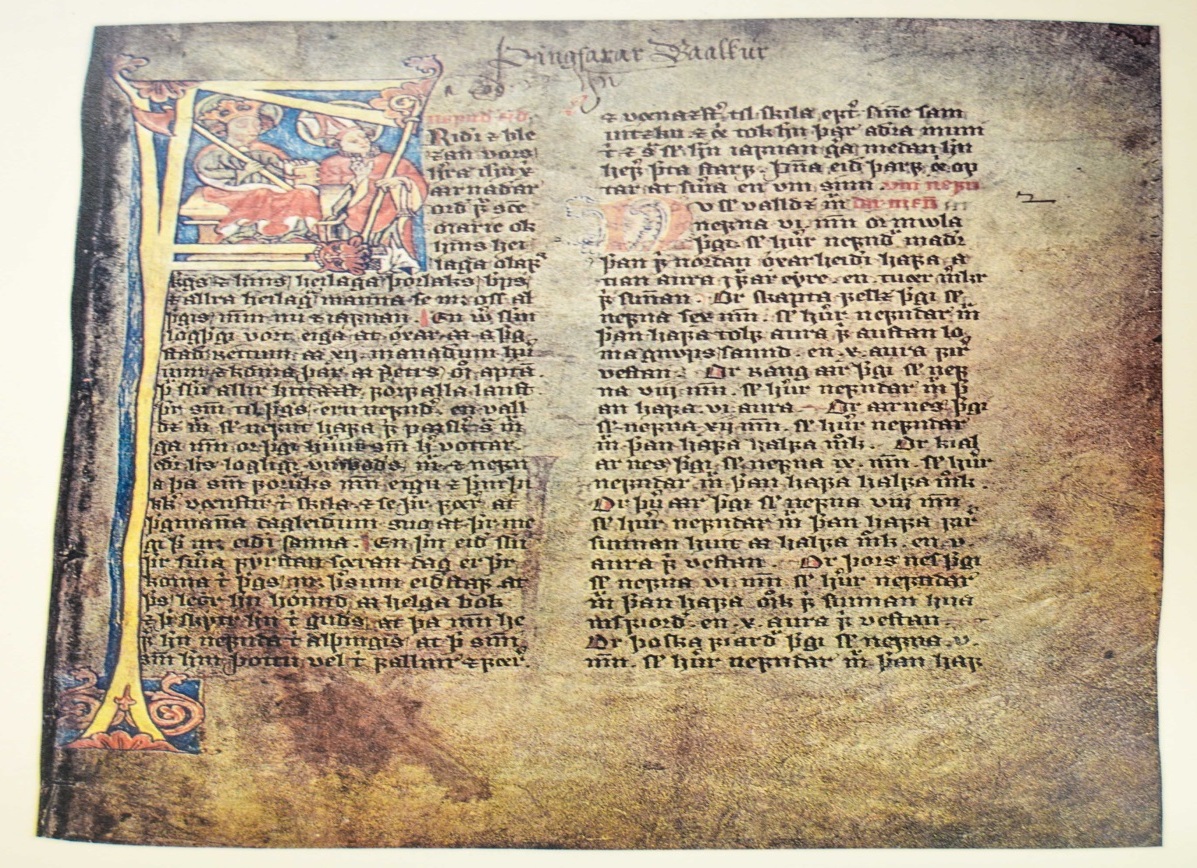|
Járnsíða
Járnsíða (, ''ironside'') was a law-code which Magnus VI of Norway had composed for Iceland, which came formally under Norwegian control during 1262–1264. ''Járnsíða'' was introduced over 1271–1273, superseding the previous law-code ''Grágás''. Amongst other things, ''Járnsíða'' formally put all legislative powers in the hands of the King, abolished the '' goðar'', and reformed the Alþingi. In 1281, ''Járnsíða'' was itself superseded by '' Jónsbók''. See also *Law of Iceland Law of Iceland during the Commonwealth (930–1262) was decided by the ''Alþingi'' (Althing). It has changed over the years, but the legislative body is still called the Althing. History Following the settlement of Iceland around the 870s, Ic ... References *Haraldur Bernharðsson, Magnús Lyngdal Magnússon and Már Jónsson, Járnsíða og kristinréttur Árna Þorlákssonar (Reykjavík: Sögufélagið, 2005). Legal history of Iceland {{iceland-stub ... [...More Info...] [...Related Items...] OR: [Wikipedia] [Google] [Baidu] |
Law Of Iceland
Law of Iceland during the Commonwealth (930–1262) was decided by the ''Alþingi'' (Althing). It has changed over the years, but the legislative body is still called the Althing. History Following the settlement of Iceland around the 870s, Iceland lacked a unitary legal system. Already around the year 930, the chiefs of the different regions of Iceland united into a single polity. A people's assembly, the ''Alþingi'', was instituted, meeting annually to exercise both judicial and legislative activities. This included having one lawspeaker (''lǫgsǫgumaðr'') on a rotating basis. His role was to know the law by heart and inform on points of law in legal cases. The first lawspeaker is said to have been Úlfljótr, who gave Iceland its first set of laws. These are thought to have corresponded closely to the Gulating laws from Norway.Nordisk rätt , ... [...More Info...] [...Related Items...] OR: [Wikipedia] [Google] [Baidu] |
Magnus VI Of Norway
Magnus the Lawmender (1 or 3 May 1238 – 9 May 1280), also known as Magnus Haakonsson, was King of Norway from 1263 to 1280. One of his greatest achievements was the modernisation and nationalisation of the Norwegian law-code. He was the first Norwegian monarch known to have used an ordinal number, counting himself as Magnus IV. In modern sources, he is also known as Magnus VI. Early life Magnus Håkonsson was the youngest son of King Håkon Håkonsson and his wife Margaret Skulesdatter. He was born in Tunsberg and was baptised in May 1238. He spent most of his upbringing in Bergen. In 1257 his older brother Håkon died, leaving Magnus the heir-apparent to the kingdom. His father gave him the title of king the same year. On 11 September 1261, he married Ingeborg, the daughter of King Eric IV of Denmark, after she was practically abducted by King Håkon's men from the monastery she was living in. The struggle to claim Ingeborg's inheritance from her murdered father later i ... [...More Info...] [...Related Items...] OR: [Wikipedia] [Google] [Baidu] |
Grágás
The Gray Goose Laws ( {{IPA, is, ˈkrauːˌkauːs}) are a collection of laws from the Icelandic Commonwealth period. The term ''Grágás'' was originally used in a medieval source to refer to a collection of Norwegian laws and was probably mistakenly used to describe the existing collection of Icelandic law during the sixteenth century. The Grágás laws in Iceland were presumably in use until 1262–1264 when Iceland was taken over by the Norwegian crown. Origins of Icelandic law According to Ari Thorgilsson, the earliest Icelandic laws were modeled on those from the Norwegian west-coast law-province, Gulathing. These were introduced to Iceland by an immigrant from Norway named Úlfljótr, sometime during the 920's. Following several years of modification and revision, Úlfljótr's laws were approved by an initial assembly. Out of this meeting, the annual general assembly known as the Althing was established. Each following summer, Icelanders would convene at Thingvell ... [...More Info...] [...Related Items...] OR: [Wikipedia] [Google] [Baidu] |
Goði
Gothi or (plural , fem. ; Old Norse: ) was a position of political and social prominence in the Icelandic Commonwealth. The term originally had a religious significance, referring to a pagan leader responsible for a religious structure and communal feasts, but the title is primarily known as a secular political title from medieval Iceland. Etymology The word derives from , meaning "god".Byock, Jesse L. (1993). "Goði". Entry in ''Medieval Scandinavia, an Encyclopedia'' (Phillip Pulsiano, ed.), 230–231. Garland: NY and London, . It possibly appears in Ulfilas' Gothic language translation of the Bible as for "priest", although the corresponding form of this in Icelandic would have been an unattested . In Scandinavia, there is one surviving attestation in the Proto-Norse form from the Norwegian Nordhuglo runestone (N KJ65),The article ''gotiska'' in ''Nationalencyklopedin'' (1992) and in the later Old Norse form from three Danish runestones: DR 190 Helnæs, DR 192 Flemløse ... [...More Info...] [...Related Items...] OR: [Wikipedia] [Google] [Baidu] |
Alþingi
The (; ), anglicised as Althingi or Althing, is the supreme national parliament of Iceland. It is the oldest surviving parliament in the world. The Althing was founded in 930 at (' thing fields' or 'assembly fields'), about east of what later became the country's capital, Reykjavík. After Iceland's union with Norway in 1262, the Althing lost its legislative power, which was not restored until 1904 when Iceland gained home rule from Denmark. For 641 years, the Althing did not serve as the parliament of Iceland; ultimate power rested with the Norwegian, and subsequently the Danish throne. Even after Iceland's union with Norway in 1262, the Althing still held its sessions at until 1800, when it was discontinued. It was restored in 1844 by royal decree and moved to Reykjavík. The restored unicameral legislature first came together in 1845 and after 1874 operated in two chambers with an additional third chamber taking on a greater role as the decades passed until 1991 when A ... [...More Info...] [...Related Items...] OR: [Wikipedia] [Google] [Baidu] |

